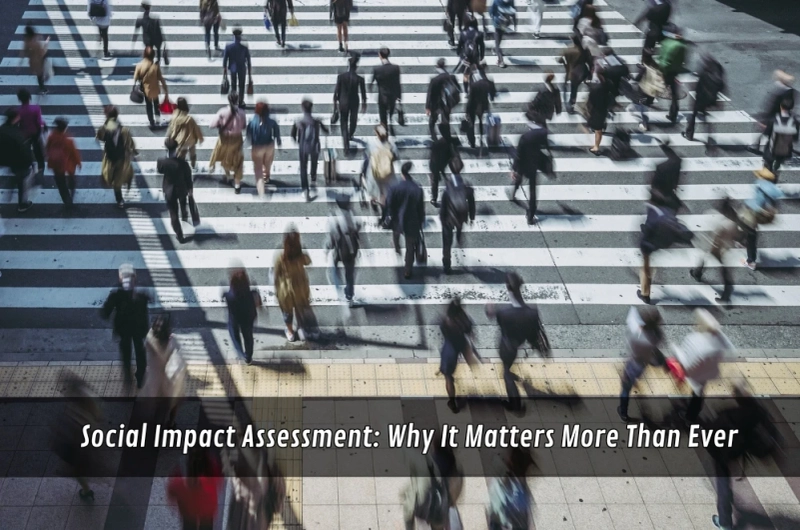The process of social impact assessment has moved from a compliance task to a critical step in delivering real value. Across sectors — from urban renewal and social housing to education and health — organisations are under increasing pressure to not only deliver services, but to prove those services make a meaningful difference. That means asking deeper questions: What changed? Who was affected? Did the benefits last? Stakeholders today are less interested in activity logs and more interested in stories of impact backed by solid data. For project teams, this shift is not just about accountability — it's about relevance, trust, and long-term learning.
Shifting focus from activity to impact
Projects that once reported on “boxes ticked” now face deeper questions: Who benefited? What changed? Did anything backfire?
I was part of a team working on youth employment pathways, where success was initially defined by enrolment numbers. But once we started listening to participants, it became clear that things like mentorship access and housing stability were stronger indicators of real impact. That shifted both our delivery and our data collection.
Benefits of reframing around impact include:
- More accurate alignment with funding or policy goals
- Better visibility of unintended outcomes
- Stronger community trust and engagement
- More resilient, data-informed program models
Build assessment into your foundation, not your finish line
The most effective evaluations start before the project even launches. Teams that leave assessment until the final report phase risk missing valuable mid-project learning and richer community input.
Starting early allows you to:
- Define success in collaboration with affected groups
- Plan realistic, context-sensitive data collection
- Allocate time and budget for ethics approvals or cultural protocols
- Avoid shallow or tokenistic feedback gathering
When assessment is embedded from the beginning, it becomes a working tool, not a retrospective box-tick.
Draw on trusted public frameworks when needed
Many government-funded programs require structured, transparent reporting — especially where outcomes involve vulnerable communities. When there’s pressure to get it right, existing resources can help.
Australia’s Department of Social Services offers well-established guidelines and principles for social impact assessment, which we’ve relied on in past projects where funders needed consistency and comparability across regions.
These kinds of frameworks can help teams:
- Align project goals with measurable change
- Document both successes and challenges with confidence
- Justify spending and future funding bids
- Build internal evaluation capacity
Why the community voice can’t be sidelined
Assessments that don’t involve participants often miss the mark. No one understands the effect of a program better than the people it touches.
I remember working on a neighbourhood transport upgrade that focused on new bus routes. But through conversations with local carers and seniors, we learned that accessible seating and signage mattered far more than frequency. Those insights reshaped the design.
Using community engagement strategies during both planning and assessment phases ensures you’re measuring the right things, not just the most obvious ones.
Pick methods that fit the shape of your work
Impact assessments come in many forms — and the best one is the one that suits your audience, scale, and timeline.
Depending on your needs, you might use:
- Outcome journals from staff or participants
- Short video diaries to track lived experience
- Thematic focus groups for qualitative shifts
- Before/after case profiles for targeted interventions
Smaller teams shouldn’t feel pressure to produce university-level reports. What matters is that your approach captures what success really means to the community involved.
Who should interpret the results? It matters

Impact data doesn’t speak for itself. The way you interpret it shapes not just your reporting, but your future strategy. And if only internal teams are involved in that process, you risk missing the nuance behind the numbers.
Strong interpretation processes include:
- Bringing community reps or peer workers into review sessions
- Validating findings with people who participated in the project
- Flagging contradictions, limitations, or ethical concerns
- Stress-testing conclusions with independent voices
We’ve seen cases where a graph showed steady progress, but on-the-ground interviews revealed fatigue, frustration, or unintended harm. Good interpretation isn’t about protecting optics — it’s about protecting learning.
Don’t let findings gather dust
Once a project wraps up, the real test is what happens next. For too many teams, impact reporting becomes a static task — a document created to fulfil a contract, not a tool to guide evolution. But social impact data is most powerful when it's activated across future work, decision-making, and relationships.
To make findings matter long after the report is written:
- Share results in formats tailored to different audiences — not just PDFs
- Use outcome data to refine internal processes or staff training
- Bring findings into planning sessions for the next project phase
- Revisit impact goals with community stakeholders annually
- Integrate results into grant proposals, impact dashboards, or public communications
When you're serious about measuring project outcomes, you start treating impact data not as a requirement, but as an asset. It becomes part of the organisational memory — something you return to, build on, and share transparently. That’s where trust is built. That’s where long-term credibility begins.
Conclusion
Social impact assessment isn’t just a reporting obligation — it’s a mindset shift. When built into the DNA of a project, it becomes a way of working that invites reflection, accountability, and continuous improvement. It keeps teams connected to purpose, challenges assumptions, and ensures that community outcomes remain at the centre of delivery. As expectations rise across sectors, the organisations that will lead aren’t those with the flashiest metrics — they’re the ones asking the right questions, listening closely, and using what they learn to grow smarter, fairer, and more responsive with every step.


